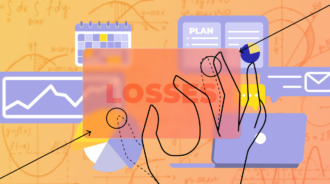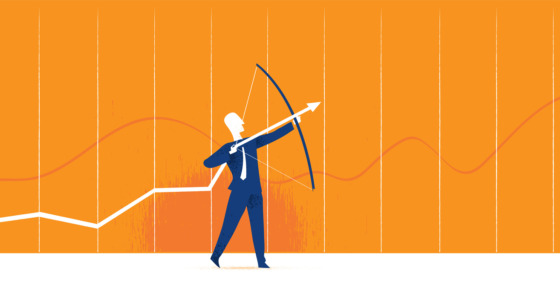

Newbie traders focus on various trading strategies and forget about risk management. Most traders don’t even know what risk management is and why it’s so important for their success in the market. The world acknowledged the role of risk management only after World War II when it was focusing on pure risks, excluding financial ones. The concept of financial risk management started to prosper only in the 1980s, which was focused on tackling corporate financial risks. Today, however, it’s an integral part of both personal and corporate finance.
Below, you will find different risk management approaches and will learn how to distinguish types of returns and losses.
Create a plan
Before you learn how to maintain risks, you should define how much you can risk per trade.
Many newbies are so excited about trading that they forget about a trading plan. Consider day trading as a serious activity.
A well-structured plan is half of your success.
You need to know in advance how much capital you are ready to spend per trade. This amount will change over time, but every time you open a new position, you need to have a clear idea of how much funds you can allocate.
These are questions that will help you determine the amount of funds you are ready to put in one trade:
- Will you manage your funds by yourself, or will there be a person who you trust?
- How many strategies will you use?
- What type of strategy will you apply — discretionary or systematic/automated?
It’s vital you don’t spend the funds required for basic needs, including food and accommodation.
Remember that the day trading approach should be one of several diversified trading strategies you use. Perhaps you opened three trades with different strategies but with equal potential rewards. If one is losing and two are successful, your day trading may be considered successful.
Risk management and trading strategies
After you determine how much you can spend on trading, determine a trading strategy you will apply. There are two key strategy categories — discretionary and systematic/automated. Using a discretionary strategy, you may ignore some trading signals. A systematic approach is more strict, as requires you to enter a trade when you get a signal. There, you manage risks based on predetermined criteria.
1. Risk management for the systematic day trading strategy
When applying a systematic day trading strategy, you limit the impact of human emotions on the success of your trade. Risk management can be backtested on historical data to define whether the approach is effective. As a result, you gain more confidence in your trading approach. Moreover, you can test it on a demo account using real-time data. Demo-account trading can be called a must. It will allow you to improve the strategy and confirm its effectiveness once again.
2. Risk management for the discretionary day trading strategy
If you plan to act on your own, you should define your risk management strategy before entering the market. It may be harder because the systematic approach is based on technical analysis tools that have proven rules for entry and exit points. While it is not required to use the same risk-to-reward formula for every trade following the discretionary strategy, it’s not a bad idea.
Strategy returns: types
Before you calculate risks, you should learn some important information about returns. You may be surprised that there are kinds of returns. However, it’s important to divide them to make a more comprehensive trading plan.
- The basic return type is when your returns for successful trades outweigh your losses on failed positions. In other words, you need to get more than you lose.
- It’s also possible to have more losing trades. However, the amount of funds you receive on successful ones will significantly exceed the losses.
- Another opportunity to gain returns is when the number of successful trades is larger than of losing ones. The amount of funds you receive could be either equal to or slightly less than the amount you lose.
You may be confused, so here are some examples.
Imagine you want to open seven trades on different assets within one trading day. If you have more successful trades than losing, you can have the same amount of returns for each trade.
For example, if you have four successful trades of $100, your return is $400. However, you lose $100 for each of the rest trades, and the overall loss is $300. Still, there is a total return of $100.
If you have more losing trades, you will need to have higher potential rewards for successful positions. For instance, receiving $200 for three successful trades, your return is $600. Even if you have four losing trades of $100 each, your overall income will be $200.

Measure risks
Risk management is based on the assumption of how much capital you could lose on one trade. It’s a potential loss not realized.
To measure a potential risk you may bear, predetermine how much loss you want to bear.
When trading, it’s not difficult to determine the loss you may have. Every successful trader defines take-profit and stop-loss orders in advance. These are the points where they will exit the market either with rewards or with losses. Take-profit and stop-loss levels reduce the risks significantly. The risk should be predicated on potential returns.
Risk/reward ratio and technical analysis
Remember that your rewards should always be bigger than losses. The most common risk-reward ratios are 1:2 and 1:3. This means that your losses should be at least two or three times less than the potential rewards from one trade.
There are chart patterns and technical indicators that will help you define entry and exit points. For example, you know that the price of a position is supposed to rise after it breaks above the neckline of the double top pattern. The distance it will go up is likely to be the same as the distance between the bottom and neckline. Thus, you know the potential reward. By applying a risk-reward ratio, you can define the stop-loss level.
Tips for effective risk management
- Determine the average price movements of the asset you trade.
- Calculate how much you can receive or lose for one trade in advance.
- If you trade currencies, you can measure the price movements in pips or percentages. If you trade stocks, price movements can be calculated in the currency of listing.
- It’s recommended to diversify trading with several strategies. Using several approaches, you reduce risks. If one strategy fails, another one will more likely compensate for the losses.
Consider the one-percent rule
Day traders have a thing they call the “one-percent rule.” To put it simply, this rule suggests that you should never use more than 1% of your capital for one trade. For example, if your capital is a total of $10,000, then you shouldn’t give more than 100 to open your position.
This trading strategy is very useful for those who have a smaller sum in their trading accounts. If you have more than $10,000 and can afford the loss, you may go as high as 2% – but remember, the smaller the percentage, the less you will be affected by the potential loss.
Setting stop-loss and take-profit points
Stop losses are price points used to minimize the loss you take in a trade. If the trade does not go as expected and goes below a certain point, a stop-loss will kick in and announce you to sell the stock, therefore preventing even more losses.
On the other hand, take-profits are price thresholds that a trader may use to make a profit. If your trade is in the take-profit stage, it means you have reached your goal and it is time to sell. This will prevent frustrations if the price suddenly goes against you, losing profits that you could have otherwise won.
Calculating expected return
To calculate expected returns, you need two price values: your stop loss and your take-profit. This calculation is very important for a trader, as it helps you think rationally through your trade. Use the following formula:
Expected Return = [(Probability of Loss) x (Stop-Loss % Loss)] + [(Probability of Gain) x (Take Profit % Gain)]
As an active trader, you will measure the result of this equation against your opportunities. It will tell you precisely which stocks you should trade for the most profit.
Takeaway
Risk management is a vital part of any trading approach, especially if you plan to open many trades within such a short period as one day. Create a trading plan, know how much you want to risk, define a potential loss for each trade, and place stop-loss and take-profit orders before you enter the market.
Disclaimer: No strategy can guarantee a 100% correct outcome of the trade.










